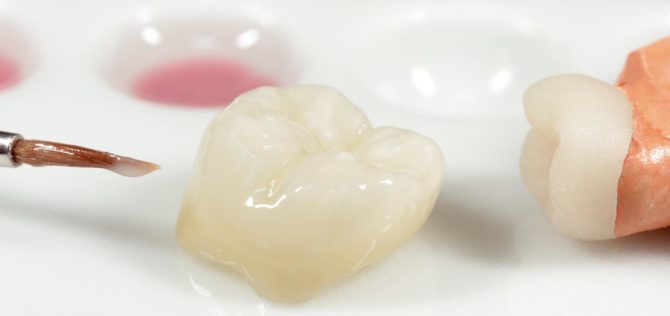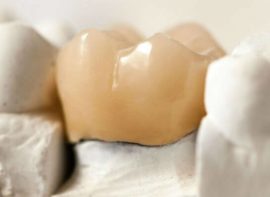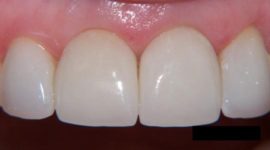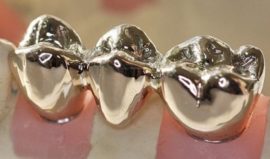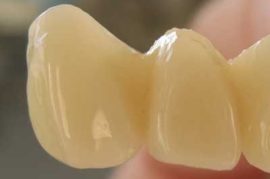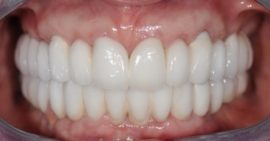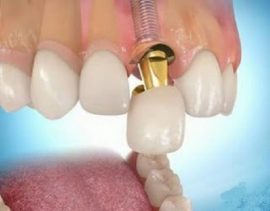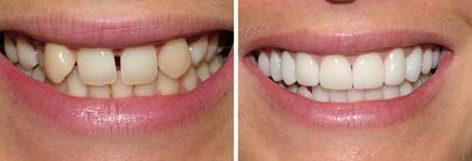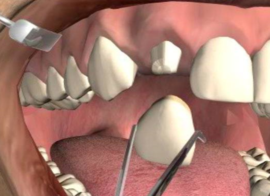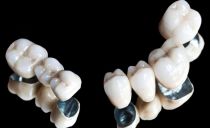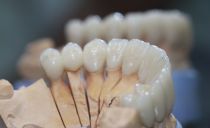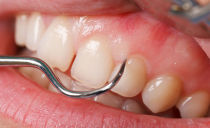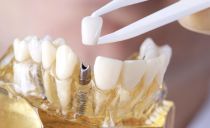Crowns on teeth: types, pros, cons and installation procedure
Few people are fortunate enough to have healthy, even teeth. Therefore, you have to look methods for correcting the appearance of the dentition and restoration of chewing function. Artificial dental crowns, which have long been used in dentistry, turned out to be very convenient in this regard. In modern clinics, you can choose the best option for price and quality, there are prostheses from different materials, with different installation technologies.
Content
Indications for installation
Crown prosthetics are used in such cases:
- The destruction of the natural crown of the tooth is more than half.
- Correction of the position and anatomical shape of the natural crown.
- Intensive erosion of the tooth surface.
- Defects on the surface of the tooth.
- Fluorosis
The decision on the installation of the crown is made by the patient himself, the dentist can only recommend prosthetics, as well as advise the kind of prosthesis, the material from which it can be made and the method of fixation.
Contraindications to prosthetics
Not in all cases it is possible to carry out prosthetics with crowns. For this, there are such contraindications:
- Too little tooth crown residue.
- Individual intolerance to the material from which the prosthesis is made. In this case, you can choose a hypoallergenic material.
- Periodontal disease.
- Bite defects.
- Insufficient tooth fixation in the gums.
- Children and adolescents: up to 16 years.
There are also contraindications for installing crowns mounted on pins:
- Periodontal injury.
- Blood diseases.
- Diseases of the nervous system.
- Obstruction in the dental canals, in which it is impossible to fill them.
- Cyst at the top of the tooth root.
Varieties of crowns
Depending on what material is used to make the prosthesis, what is its design, and for what purpose it is installed, crowns are:
| Crowns classification | Scroll | Description |
|---|---|---|
| By appointment | Supporting | To install a bridge. |
| Recovery | To restore a damaged or lost tooth - a dental crown for one tooth. | |
| By design | Full | Completely replacing a tooth. |
| Equatorial | Girdle the tooth in a circle to increase strength.
|
|
| Half-crowns | Prosthetic natural crown, except for its internal part. | |
| Stump | Recessed lower part of the gum. | |
| Pin | Fastened to a pin that replaces a destroyed root. | |
| Telescopic | With the possibility of changing the height in the future. | |
| By material | Ceramic-metal crowns | Inside there is a metal frame, outside there is a ceramic cladding. |
| Metal crowns | Solid cast, gold, stamped. | |
| Metal-composite, metal-plastic crowns | Inside - a metal frame made of gold or platinum, outside - a plastic lining. | |
| Ceramic white crowns on teeth | From porcelain, zirconia. |
Advantages and disadvantages
The advantages of dental crowns are aesthetics and the ability to preserve chewing teeth for a long time. Their disadvantage is that it is necessary to injure neighboring teeth used as a support. It is also necessary to carry out depulpation, after which there are sometimes complications. For certain types of crowns, the pros and cons are as follows:
| Crown material | Benefits | disadvantages |
|---|---|---|
| Ceramic-metal dental crowns
|
Durable, hypoallergenic material, long service life. Can be installed without killing the nerve. | When lifting the gums, the metal part of the crown is exposed, it is necessary to sharpen the tooth strongly. |
| Metal crowns
|
They do not require strong grinding, they are placed only on the posterior chewing teeth without losing the aesthetics of the smile. Strong, wear-resistant, relatively inexpensive. | They do not look aesthetically pleasing, differ in color from the dentition, rarely put on the front teeth. Stamped sometimes “eat”, poorly fit. |
| Metal-composite, metal-plastic crowns
|
Relatively inexpensive, with a good aesthetic appearance. | Over time, the white color of the plastic is lost, it is not strong enough and can cause intolerance. |
| Ceramic crowns
|
Good appearance, the shade is close to the natural color. Strong, durable. | Less durable than cermet, expensive, suitable only for crowns on one tooth. |
The choice of crown type depends on the wishes of the patient and financial capabilities, individual characteristics, the presence of an intolerance reaction to a particular material.
Methods for fixing the crown
The doctor may fix the crown in different ways. The fixation method depends on how big the load on a given tooth is, what is the probability of a negative effect on neighboring teeth. Known methods for fixing crowns:
-
A pin (carbon fiber, zirconium, titanium) is a rod fixed in the root hole with a hardening solution. It is put quite simply, but the procedure is very unpleasant for the patient.
- The tab (cobalt-chromium, zirconium) is an artificial cast stump that replaces the lower part of the tooth, is inserted into the root canals and fixed in them with a hardening solution. If necessary, they are made prefabricated and branched. This design is more durable than when mounted on a pin.
- Installation of a crown with support on implants (fiberglass, titanium, plastic) - fixing the prosthesis on a screw, which replaces the roots in the absence of a tooth.
Preparation for prosthesis installation
Dental prosthetics with crowns is a kind of intervention, which, if improperly prepared, can lead to complications. Before starting the manipulations, it is necessary to bring the oral cavity in full order, there should be no sources of infection in it. Therefore, the dentist performs the following procedures:
- The purpose of the x-ray.
- Elimination of tartar.
- Treatment of carious teeth.
- Removing teeth that are not treatable.
- Elimination of inflammatory processes of the gums and oral mucosa.
After rehabilitation, it is necessary to prepare the tooth itself to ensure full fit of the crown; for this, the hard tissues of the natural crown are turned by 1-2 mm in thickness. Due to unpleasant sensations, local anesthesia is done before the procedure.
There is a risk of damage to the pulp when turning under the influence of high temperature, therefore, more often carry out preliminary depulpation with further filling of the canals. If the pulp remains, and the dentist damages it, it can then become inflamed, being already under an artificial crown, and this adds additional complications to treatment.
The posterior chewing teeth have a rather thick natural crown part, so they can be left with live nerves.
Prosthesis manufacturing
The next step is to make a mold of the tooth. In the dental laboratory, on the basis of this cast, a plaster mold is cast, which will serve as a model for the manufacture of an artificial prosthesis from the selected material.
Between turning or removing a tooth and completing the installation of the prosthesis, a lot of time passes, the patient has to walk with a damaged dentition.To prevent the defect from being noticeable during this period, the dentist installs a temporary plastic crown on unstable cement.
Prosthesis installation
Installing a permanent crown is a very serious step, since all manipulations after fixing it on a permanent cement will be difficult. Therefore, preliminary preparation is required:
- The dentist tries on a manufactured prosthesis, checks its quality, fit.
- The constituent parts of the crown, made of metal and ceramics, are combined into a single design.
- The prosthesis is placed on temporary cement, which allows you to walk with it for a while and check how it looks, if there are any defects in shape or fit, if teeth located on the opposite jaw are injured.
Only after a successful verification step, which lasts a couple of weeks, is the prosthesis on one or several teeth placed on permanent dental cement. Caring for prosthetics is no different from normal oral hygiene: They are also cleaned with a toothbrush and toothpaste (or powder), paying particular attention to the back teeth, where plaque and bacteria can accumulate.
Is it possible to remove the prosthesis
Despite the fact that modern crowns are made of very durable materials, even they can deteriorate, after which it is necessary to remove the prosthesis. Sometimes other problems arise, for example, the initiation of the inflammatory process under construction.
The crown can be removed, but this process is very complicated due to its strong attachment, it is carried out using a large set of special tools. Removal of the prosthesis is carried out in such cases:
-
Expiration of operation.
- The presence of damage, deterioration in appearance.
- A fracture of the tooth root or the appearance of an opening in the dental wall.
- Identification of improper fit.
- Inflammation of the tooth tissue under the prosthesis after poor-quality dental services, for example, if the prosthesis is placed without depulping, filling, and an infection develops in the tooth chamber.
- The formation of cysts or granulomas under the prosthesis.
If the patient feels uncomfortable while chewing or talking, or there is pain after installing the prosthesis, an urgent need to go to the dentist to fix such problems. Sometimes it is necessary to completely remove the damaged prosthetic tooth and install a different type of prosthesis in its place.
Dental crowns are a good solution for those patients who have an incomplete dentition or have defects on an existing tooth. Modern dentistry offers a fairly wide variety of prostheses: white and metal, more expensive or cheaper options.
A well-mounted crown looks almost the same as a natural tooth. But the most important thing is the correct installation and preliminary preparation of the oral cavity for complex manipulations, because the health of the patient, the functioning of the teeth, and the utterance of speech depend on this. Therefore, you need to be serious about choosing a clinic and a specialist in prosthetics.

